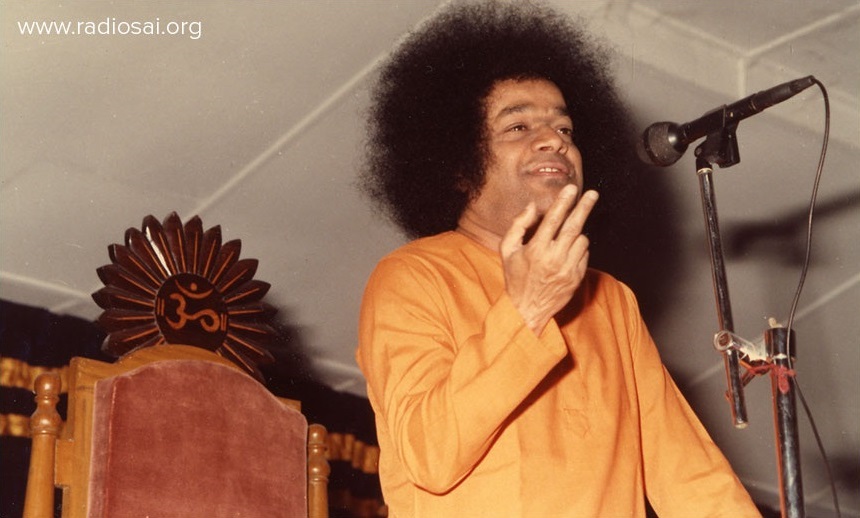
Sri Sathya Sai Speaks
Divine Discourses spanning 7 Decades (1950 – 2011)
Ramakatha Rasa Vahini, Vol 2 (Download)
| |
The Inner Meaning
Rama is the indweller in every body. He is the source of bliss (the Atma Rama) in every individual. His blessings upsurging from that inner spring can confer peace and bliss. He is the very embodiment of dharma of all the codes of morality that hold mankind together in love and unity.
The Ramayana, the Rama story, teaches two lessons: the value of detachment and the need to become aware of the Divine in every being. Faith in God and detachment from objective pursuits are the keys for human liberation.
Give up sense objects, and you gain Rama. Sita gave up the luxuries of Ayodhya so she could be with Rama in the period of “exile”. When she cast longing eyes on the golden deer and craved it, she lost the Presence of Rama. Renunciation leads to joy; attachment brings about grief. Be in the world, but not of it.
The brothers, comrades, companions, and collaborators of Rama are examples of persons saturated with dharma. Dasaratha is the representative of the merely physical, with the ten senses. The three qualities (gunas) – serenity, activity, passivity (sathwa, rajas, thamas) – are the three queens. The four goals of life (purusha-arthas) are the four sons. Lakshmana is the intellect; Sugriva, discrimination (viveka). Vali is despair; Hanuman, the embodiment of courage. The bridge is built over the ocean of delusion. The three demon (rakshasa) chiefs Ravana, Kumbhakarna, and Vibhishana are personifications of the active (rajasic), passive (thamasic), and pure (sathwic) qualities. Sita is the awareness of the Universal Absolute (Brahma-jnana), which the individual must acquire and regain while undergoing travails in the crucible of life.
Make your heart pure and strong, contemplating the grandeur of the Ramayana. Be established in the faith that Rama is the reality of your existence.
– Bhagawan Sri Sathya Sai Baba
Preface – This Book
For many centuries, the Rama story, Stream of Sacred Sweetness, has been for millions of men, women, and children the perennial source of solace during sorrow, vitality when floored by vacillation, illumination while confounded, inspiration in moments of dejection, and guidance while caught in quandaries.
It is an intensely human drama in which God impersonates as man and gathers around Him, on the vast world-stage, the perfect and the imperfect, the human and the subhuman, the beast and the demon, to confer on us, by precept and example, the boon of Supreme Wisdom. This story plays its tender fingers on the heartstrings of people, evoking lithe, limpid responses of pathos, pity, exultation, adoration, ecstasy, and surrender and transforming us from the animal and the human into the Divine, which is our core.
No other story in human history has had such a profound impact on the minds of people. It transcends the milestones of history and the boundaries of geography. It has shaped and sublimated the habits and attitudes of generations. The Ramayana, the Story of Rama, has become a curative corpuscle in the blood stream of mankind, over vast areas of the globe. It has struck root in the conscience of peoples, prodding and prompting them along the paths of truth, righteousness, peace, and love.
Through legends, lullabies, myths, and tales, through dance and drama, through sculpture, music and painting, through ritual, poetry, and symbol, Rama has become the breath, the bliss, the treasure of countless spiritual seekers (sadhakas). The characters in the Rama Story have invited them to emulation and to be elevated themselves.
They have provided shining examples of achievement and adventure; they have warned the wavering against vice and violence, pride, and pettiness; they have encouraged them by their fidelity and fortitude. To every language and dialect that humanity has devised for the expression of their higher desires, the Story of Rama has added a unique, sustaining sweetness.
Sai (Isa, God), whose thought is the universe, whose will is its history, is the author, director, actor, witness, and appraiser of the drama that is ever unfolding in time and space. He has now deigned to tell us Himself the story of this one epic act in that drama, wherein He took on the Rama role. As Rama, Sai instructed, inspired, invigorated, corrected, consoled, and comforted His contemporaries in the Thretha age. As Sai Rama, He is now engaged in the same task. Therefore, most of what the readers of Sanathana Sarathi perused month after month (during these years) with ardour and pleasure, as instalments of this narrative – the Ramakatha Rasa Vahini – must have appeared to them as “contemporary events and experiences” and “direct counsel to them in the context of contemporary problems and difficulties”. While reading these pages, readers will often be pleasantly struck by the identity of the Rama of this story and the Sai Rama they are witnessing.
“Science” has moulded this earth into the compactness and capsularity of a spaceship in which mankind has to live out its destiny. “Sai-ence” is, we know, fast moulding this spaceship into a happy home of love. This book must have been willed by Sai as a paramount panacea for the removal of the ills that obstruct that universal love – the morbid itch for sensual pleasure, the mounting irrever-ence toward parents, teachers, elders, spiritual leaders, and guides, the disastrous frivolity and flippancy in social, marital, and familial relationships, the demonic reliance on violence as a means of achieving immoral ends, the all-too-ready adoption of terror and torture as means of gaining personal and group gains, and many more evils besides.
Sai Rama has recapitulated herein, in His own simple, sweet and sustaining style, His own divine career as Rama! What great good fortune it is to have this divine narrative in our hands, to inscribe it on our minds, to imprint it on our hearts! May we be processed by the study of this book into efficient and enthusiastic tools for consummating His mission of moulding mankind into one family, of making each one of us realise Sai Rama as the reality, the only reality that IS.
Sai has declared that He is the same Rama come again and that He is searching for His erstwhile associates and workers (bantu, as He referred to them in Telugu) in order to allot them roles in His present mission of resuscitating righteousness and leading humanity into the haven of peace. While ruminating over the second half of this story, let us pray that we too be allotted roles, and may He grant us, as reward, the vision of that Haven.
N. Kasturi
Editor, Sanathana Sarathi
Prasanthi Nilayam
14 January 1984 $(“.alert.alert-block.alert-danger.messages.error, .alert.alert-block.alert-success.messages.status”).remove(); Index of All Discourses Choose Collection and Title to navigate to the Discourse Discourse Title Discourse Search Akhanda Bhajan Discourses Avatar Day Discourses Birthday Discourses Devotional Songs Search Sai Rhythms App for Android Sai Rhythms App for iOS advaita: 3 age: 1 ant: 2 anxiety: 1 arjuna: 1 avatar: 3 Bhagavad Gita: 2 bhagavatham: 14 bhajans: 1 bird: 2 birthday: 1 brahmacharya: 1 brahman: 1 buddha: 2 character: 2 chastity: 3 compassion: 2 cooking: 1 creation: 2 daya: 2 declaration: 3 desire for god: 1 detachment: 4 devotion: 9 dharma: 2 difficulties: 1 discipline: 2 discrimination: 1 do not judge: 2 doctor: 1 easwaramma: 4 education: 4 ego: 1 ehv: 1 ekadasi: 4 equanimity: 1 faith: 3 feeling: 2 five principles: 2 flute: 2 food: 8 forbearance: 1 freewill: 1 gayathri: 8 gita: 36 god: 3 god is one: 4 god&
